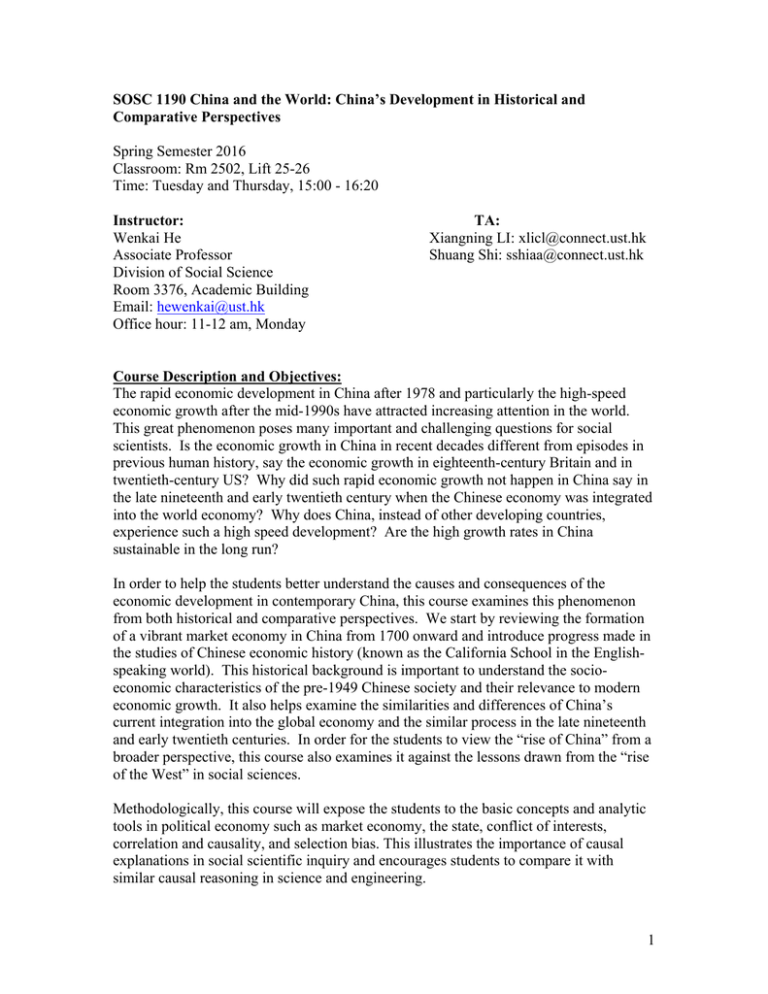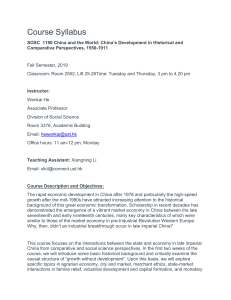1 SOSC 1190 China and the World
advertisement

SOSC 1190 China and the World: China’s Development in Historical and Comparative Perspectives Spring Semester 2016 Classroom: Rm 2502, Lift 25-26 Time: Tuesday and Thursday, 15:00 - 16:20 Instructor: Wenkai He Associate Professor Division of Social Science Room 3376, Academic Building Email: hewenkai@ust.hk Office hour: 11-12 am, Monday TA: Xiangning LI: xlicl@connect.ust.hk Shuang Shi: sshiaa@connect.ust.hk Course Description and Objectives: The rapid economic development in China after 1978 and particularly the high-speed economic growth after the mid-1990s have attracted increasing attention in the world. This great phenomenon poses many important and challenging questions for social scientists. Is the economic growth in China in recent decades different from episodes in previous human history, say the economic growth in eighteenth-century Britain and in twentieth-century US? Why did such rapid economic growth not happen in China say in the late nineteenth and early twentieth century when the Chinese economy was integrated into the world economy? Why does China, instead of other developing countries, experience such a high speed development? Are the high growth rates in China sustainable in the long run? In order to help the students better understand the causes and consequences of the economic development in contemporary China, this course examines this phenomenon from both historical and comparative perspectives. We start by reviewing the formation of a vibrant market economy in China from 1700 onward and introduce progress made in the studies of Chinese economic history (known as the California School in the Englishspeaking world). This historical background is important to understand the socioeconomic characteristics of the pre-1949 Chinese society and their relevance to modern economic growth. It also helps examine the similarities and differences of China’s current integration into the global economy and the similar process in the late nineteenth and early twentieth centuries. In order for the students to view the “rise of China” from a broader perspective, this course also examines it against the lessons drawn from the “rise of the West” in social sciences. Methodologically, this course will expose the students to the basic concepts and analytic tools in political economy such as market economy, the state, conflict of interests, correlation and causality, and selection bias. This illustrates the importance of causal explanations in social scientific inquiry and encourages students to compare it with similar causal reasoning in science and engineering. 1 Requirements: Read the assigned readings before the class and participate into class discussion. Grading: Participation: 20%。 Participation consists of class attendance, participation in class discussion, as well as the discussion forum of the course website. Two exams: each consists of some factual questions and a few essay questions Mid-term exam: 40% Final exam: 40% If you don’t want to take exams, you can choose to write two short analytical essays (8 pages, double-spaced). I will give you the topic and requirements one week before the due date. Readings: Part I: Late Imperial China Week 1: Introduction and organization How to understand the rise, or possible rise, of China as a world power from a social science perspective? Paul Krugman, “The Myth of East Asian Miracle,” Foreign Affairs, Nov./Dec. 1994 Susan Naquin and Evelyn S. Rawski, Chinese Society in the Eighteenth Century (New Haven: Yale University Press, 1987), pp. 138-216. Week 2: Growth without development in late imperial China: (1500-1842)? John K. Fairbank and Merle Goldman, China: A New History, enlarged edition (Cambridge: The Belknap Press of Harvard University Press, 1998), pp. 167-186. Mark Elvin, The Pattern of the Chinese Past (Stanford: Stanford University Press, 1973), pp. 298-315. Week 3: Cultural value and the rise of capitalism: China vs. the West Max Weber, The Protestant Ethic and the Spirit of Capitalism (New York: Charles Scribner’s Sons, 1976), “Author’s Introduction”, pp. 13-27 and chapter 2 “The spirit of capitalism,” pp. 47-78. Richard J. Lufrano, Honorable Merchants: Commerce and Self-Cultivation in Late Imperial China (Honolulu: University of Hawai‘i Press, 1997), pp. 51-67. Week 4: Famine relief in late imperial China: State and Economy 2 Lillian M. Li, Fighting Famine in North China: State, Market, and Environmental Decline, 1690s-1990s (Stanford: Stanford University Press, 2007), chapter 8, “Famine Relief: The High Qing Model,” pp. 221-49. Pierre-Etienne Will, Bureaucracy and Famine in Eighteen-Century China, translated by Elborg Forster (Stanford: Stanford University Press, 1990), chapter 12, “The evolution of the state’s economic means,” pp. 289-301. Week 5: A revisionist view of the pre-20th century Chinese economy Madeleine Zelin, The Merchants of Zigong: Industrial Entrepreneurship in Early Modern China (New York: Columbia University Press, 2005), chapters 1 and 2 Kenneth Pomeranz, The Great Divergence: China, Europe and the Making of the Modern World (Princeton: Princeton University Press, 2000), “Technology?” pp. 43-68 Week 6: The deadly good: the opium trade in the economic perspective Lin Man-houng, China Upside Down: Currency, Society, and Ideologies, 1808-1856 (Cambridge: The Harvard University of Asia Center of the Harvard University Press, 2006), Part I: “Global Links: Silver and the World”, chapter 1: “A Vulnerable Empire,” pp. 29-71 chapter 3, “Disturbance of the Social Order,” pp. 115-143. Part II. Modern China Week 7: Historical continuity between the Republic of China and the People’s Republic of China: The model of a planned economy William C. Kirby, “Continuity and change in modern China: economic planning on the Mainland and Taiwan, 1943-1958,” Australian Journal of Chinese Affairs 24 (1990): 121-141. Week 8: The 1950s: Great Leap Forward (1958-1960) and the Great Famine John K. Fairbank and Merle Goldman, China: A New History (Cambridge: The Belknap Press of Harvard University Press, 1998), pp. 345- 376. Felix Wemheuer, Famine Politics in Maoist China and the Soviet Union (New Haven: Yale University Press, 2014), pp. 78-114. Week 9: “Scientific” policy-making: the case of one-child policy in China Barry Naughton, The Chinese Economy (Cambridge, MA.: The MIT Press, 2007), “Population growth and the one-child policy,” pp. 161-177. Susan Greenhalgh, “Missile Science, Population Science: The Origins of One-Child Policy,” China Quarterly, No. 182 (June 2005): 253-276. Recommended: Charis Loh and Elizabeth J. Remick, “China’s Skewed Sex Ratio and the One-Child Policy,” The China Quarterly, Vol. 222 (June 2015): 295-319. 3 Week 10: Economic development in the 1980s Ezra Vogel, Deng Xiaoping and the Transformation of China (Cambridge, Mass. : Belknap Press of Harvard University Press, 2011), pp. 349-476, 553-591. Week 11: Internationalization and global economic linkages Yasheng Huang, Selling China (New York: Cambridge University Press, 2003), chapter 1 “Introduction,” pp. 1-62. Edward S. Steinfeld, Playing Our Game: Why China’s Economic Rise Doesn’t Threaten the West (New York: Oxford University Press, 2010), pp.70-119. Week 12: The theory of collective action problem and its application to China Mancur Olson, The Logic of Collective Action: Public Goods and the Theory of Groups (Cambridge, MA: Harvard University Press, 1965), pp. 5-22 and pp. 33-52. Week 13: Economic development and Democracy in China: correlation or causation? Bruce J. Dickson, Wealth into Power: The Communist Party’s Embrace of China’s Private Sector (Cambridge: Cambridge University Press, 2008), pp. 1-27. Yasheng Huang, Capitalism with Chinese Characteristics: Entrepreneurship and the State (New York: Cambridge University Press, 2008), “How Capitalist is China,” pp.1-24. 4


